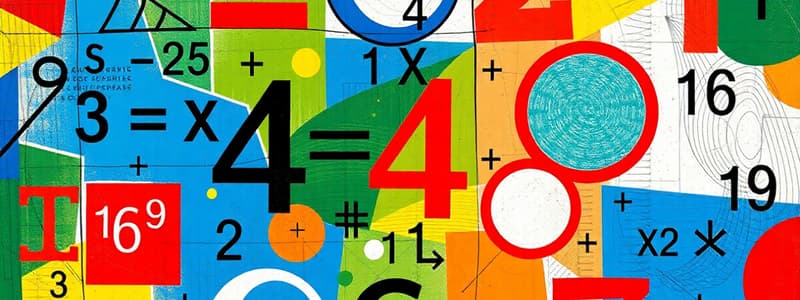Podcast
Questions and Answers
Which branch of mathematics is most directly concerned with determining the area under a curve?
Which branch of mathematics is most directly concerned with determining the area under a curve?
- Differential Calculus
- Analytic Geometry
- Integral Calculus (correct)
- Trigonometry
In the context of mathematical modeling, which of the following professions would least likely utilize mathematical models extensively in their day-to-day work?
In the context of mathematical modeling, which of the following professions would least likely utilize mathematical models extensively in their day-to-day work?
- Historian (correct)
- Engineer
- Economist
- Sociologist
Which area of mathematics focuses on the properties of shapes and spaces that remain unchanged under continuous deformations like stretching and bending?
Which area of mathematics focuses on the properties of shapes and spaces that remain unchanged under continuous deformations like stretching and bending?
- Topology (correct)
- Geometry
- Trigonometry
- Calculus
If a mathematician is working on the security of online transactions, which branch of mathematics is most likely to be relevant to their work?
If a mathematician is working on the security of online transactions, which branch of mathematics is most likely to be relevant to their work?
A computer scientist is designing an algorithm to find the shortest route between two cities. Which branch of mathematics is most applicable to this problem?
A computer scientist is designing an algorithm to find the shortest route between two cities. Which branch of mathematics is most applicable to this problem?
To accurately predict election results using polling data, which two branches of mathematics are most crucial?
To accurately predict election results using polling data, which two branches of mathematics are most crucial?
Why are axioms important in mathematics?
Why are axioms important in mathematics?
In what way does algebra generalize arithmetic?
In what way does algebra generalize arithmetic?
How does analytic geometry bridge the gap between algebra and geometry?
How does analytic geometry bridge the gap between algebra and geometry?
Which of the following is an example of a problem best addressed by numerical analysis?
Which of the following is an example of a problem best addressed by numerical analysis?
Flashcards
What is Mathematics?
What is Mathematics?
The abstract science of number, quantity, and space, studied in its own right or applied to other disciplines.
What is Arithmetic?
What is Arithmetic?
Study of numbers and operations like addition, subtraction, multiplication, division, exponentiation, and roots.
What is Algebra?
What is Algebra?
Branch of mathematics generalizing arithmetic, using variables to represent numbers or quantities.
What is Geometry?
What is Geometry?
Signup and view all the flashcards
What is Trigonometry?
What is Trigonometry?
Signup and view all the flashcards
What is Calculus?
What is Calculus?
Signup and view all the flashcards
What is Statistics and Probability?
What is Statistics and Probability?
Signup and view all the flashcards
What is Discrete Mathematics?
What is Discrete Mathematics?
Signup and view all the flashcards
What is Numerical Analysis?
What is Numerical Analysis?
Signup and view all the flashcards
What is Topology?
What is Topology?
Signup and view all the flashcards
Study Notes
Here are the updated study notes on Mathematics:
- Mathematics is the abstract science of number, quantity, and space
- It may be studied in its own right (pure mathematics), or as it is applied to other disciplines such as physics and engineering (applied mathematics)
Arithmetic
- Arithmetic involves the study of numbers, especially the properties of the traditional operations between them—addition, subtraction, multiplication, division, exponentiation, and extraction of roots
- Arithmetic is an elementary part of number theory, and number theory is considered to be one of the top-level divisions of modern mathematics
Algebra
- Algebra is a branch of mathematics that generalizes arithmetic, introducing variables to represent numbers or quantities
- Elementary algebra is essential for any study of mathematics, science, engineering, or economics
- Abstract algebra studies algebraic structures such as groups, rings, and fields, which generalize the familiar properties of numbers
Geometry
- Geometry is one of the oldest branches of mathematics
- It is concerned with the properties of space, such as the distance, shape, size, and relative position of figures
- Plane geometry deals with flat shapes, like lines, circles, and triangles, that can be drawn on a piece of paper
- Solid geometry deals with three-dimensional objects such as cubes, cylinders, and spheres
- Analytic geometry applies algebraic techniques to geometric questions, typically by relating geometric curves to algebraic equations
Trigonometry
- Trigonometry is a branch of mathematics that studies relationships between the sides and angles of triangles
- Trigonometry is fundamental to surveying, navigation, and many branches of physics
Calculus
- Calculus is a branch of mathematics that deals with continuous change
- It has two major branches, differential calculus and integral calculus
- Differential calculus concerns the instantaneous rate of change of quantities
- Integral calculus concerns the accumulation of quantities, and the areas under or between curves
- Calculus is used extensively in physics, engineering, economics, and computer science
Statistics and Probability
- Statistics is the study of the collection, analysis, interpretation, presentation, and organization of data
- Probability is a measure of the likelihood that an event will occur
- Both statistics and probability are used in many fields, including science, engineering, medicine, and social sciences
Discrete Mathematics
- Discrete mathematics is the study of mathematical structures that are fundamentally discrete rather than continuous
- It includes topics such as logic, set theory, number theory, combinatorics, graph theory, and the theory of computation
- Discrete mathematics is essential for computer science
Numerical Analysis
- Numerical analysis is the study of algorithms that use numerical approximation for the problems of mathematical analysis
- It is used to approximate solutions to problems for which it is difficult or impossible to obtain exact solutions
- Numerical analysis is used in engineering, physics, finance, and other fields
Topology
- Topology is a branch of mathematics that studies the properties of spaces that are preserved under continuous deformations, such as stretching, twisting, crumpling, and bending, but not tearing or gluing
- Topology is related to other branches of mathematics such as geometry and analysis
Mathematical Logic
- Mathematical logic is a subfield of mathematics exploring the applications of formal logic to mathematics
- It is closely related to metamathematics, the investigation of mathematics itself using mathematical methods
- It often divides into the fields of set theory, model theory, recursion theory, and proof theory
Set Theory
- Set theory is a branch of mathematical logic that studies sets, which are collections of objects
- Set theory is fundamental to many other areas of mathematics, including algebra, analysis, and topology
- Modern set theory was founded by Georg Cantor in the late 19th century
Number Theory
- Number theory is a branch of pure mathematics devoted primarily to the study of the integers and integer-valued functions
- Number theory is one of the oldest and broadest areas of mathematics
- It has applications to cryptography, computer science, and other fields
Combinatorics
- Combinatorics is a branch of mathematics concerning the study of finite or countable discrete structures
- Aspects include counting the structures of a given kind and size (enumerative combinatorics), deciding when certain criteria can be met, and constructing and analyzing objects meeting the criteria (as in combinatorial designs and matroid theory), finding "largest", "smallest", or "optimal" objects (extremal combinatorics and combinatorial optimization)
- Combinatorics is used frequently in computer science to obtain bounds on the time and resources needed by algorithms
Graph Theory
- Graph theory is the study of graphs, which are mathematical structures used to model pairwise relations between objects
- A graph consists of vertices (also called nodes) connected by edges
- Graph theory has applications in computer science, engineering, biology, and social sciences
Functions
- In mathematics, a function is a relation between a set of inputs and a set of permissible outputs with the property that each input is related to exactly one output
- A function is commonly denoted by a letter such as f, g, or h, and the output of a function f for an input x is denoted by f(x)
- Functions are used to model relationships between quantities, and they are essential for calculus, analysis, and many other areas of mathematics
Equations
- An equation is a statement that asserts the equality of two expressions
- Equations are used to model relationships between quantities and to solve problems in mathematics, science, and engineering
- Equations can be solved using algebraic techniques, and the solutions to an equation are the values of the variables that make the equation true
Proofs
- A mathematical proof is an inferential argument for a mathematical statement
- In mathematics, a statement is not accepted as valid or accurate until it is proven
- Proofs use logic and previously established results to show that a statement is true
- Proofs are essential for establishing the validity of mathematical results
Axioms
- An axiom is a statement that is accepted as true without proof
- Axioms are used as the starting point for building mathematical theories
- The choice of axioms can have a significant impact on the resulting theory
Theorems
- A theorem is a mathematical statement that has been proven to be true
- Theorems are the main results in mathematics
- Theorems are used to build upon previous results and to develop new theories
Models
- A mathematical model is a description of a system using mathematical concepts and language
- Mathematical models are used in the natural sciences (such as physics, biology, earth science, meteorology) and engineering disciplines (e.g. computer science, artificial intelligence) as well as in the social sciences (such as economics, psychology, sociology, political science)
- Physicists, engineers, statisticians, operations research analysts, and economists use mathematical models most extensively
Importance of Mathematics
- Mathematics provides a universal system for understanding structure, pattern, and change
- It is essential for science, technology, and engineering
- It is also important for everyday life, helping us make informed decisions and solve problems
- Mathematical literacy is a valuable skill in today's world
Studying That Suits You
Use AI to generate personalized quizzes and flashcards to suit your learning preferences.




